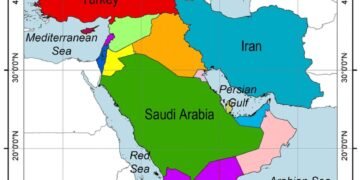PALMYRA, Syria — Archaeologists and conservationists are returning to Syria’s war-scarred heritage sites, aiming to lay the foundation for restoration efforts and eventually revive tourism. They hope that restoring these historical landmarks will provide a much-needed economic boost to a country devastated by nearly 14 years of conflict.
Once-thriving cultural and historical sites—such as the ancient city of Palmyra and the medieval Crusader fortress Crac des Chevaliers—still bear the scars of war. However, with local visitors slowly returning, preservation experts hope their significance will once again attract international tourists.
Palmyra: A Once-Bustling Hub of Trade and Tourism
Among Syria’s six UNESCO World Heritage sites, Palmyra was a vital center along the ancient Silk Road, connecting the Roman and Parthian empires to Asia. Located deep in the Syrian desert, its 2,000-year-old ruins once drew visitors from across the globe.
Before the Syrian civil war erupted in 2011, Palmyra was the country’s top tourist destination, welcoming around 150,000 visitors per month, according to researcher and ruins expert Ayman Nabu. Dubbed the “Bride of the Desert,” Palmyra was not just an archaeological treasure—it was a key driver of local economic activity.
The city was once the capital of an Arab kingdom that briefly defied the Roman Empire in the third century under the rule of the legendary Queen Zenobia. However, in recent decades, it gained notoriety for darker reasons—Tadmur prison, a notorious detention center, was located nearby. Thousands of political prisoners were reportedly tortured there before the Islamic State (IS) destroyed the facility after capturing the town.
IS militants also inflicted severe damage on Palmyra’s historic treasures, demolishing the temples of Bel and Baalshamin, toppling the famed Arch of Triumph, and executing Khaled al-Asaad, an 82-year-old antiquities scholar who had dedicated his life to preserving the site.
Between 2015 and 2017, control over Palmyra shifted multiple times between IS and Syrian government forces. Eventually, President Bashar al-Assad’s military, backed by Russia and Iran-aligned militias, recaptured the city. Military bases were established in the adjacent town, leaving it heavily damaged and largely abandoned. Russian troops repurposed the 16th-century Fakhr al-Din al-Ma’ani Castle as a military outpost.
When researcher Ayman Nabu visited Palmyra shortly after government forces regained control, he found widespread looting and destruction. Many ancient tombs had been excavated illegally, and artifacts had gone missing from the museum. While some stolen sculptures were recovered and placed in a museum in Idlib, at least 22 pieces were smuggled out—likely ending up in private collections or on the black market.
Inside Palmyra’s underground tombs, religious inscriptions have been scrawled over mythological artwork, and valuable wall paintings have been covered in plaster.
“Syria is home to an extraordinary wealth of ruins,” Nabu said, emphasizing the urgent need for preservation efforts. However, he noted that Syria’s interim administration—led by the former insurgent group Hayat Tahrir al-Sham—is waiting for the country’s political situation to stabilize before launching a long-term strategy for restoration.
UNESCO’s Role in Preservation Efforts
Matthieu Lamarre, a representative of UNESCO, stated that since 2015, the agency has provided remote support for the protection of Syria’s cultural heritage. This has included satellite analyses, documentation, and expert recommendations. However, due to security concerns, UNESCO has yet to conduct on-the-ground restoration work.
In 2019, international specialists convened by UNESCO stressed that comprehensive studies would be necessary before major restoration efforts could begin.
Crac des Chevaliers: A Crusader Fortress Scarred by War
Beyond Palmyra, other historic sites continue to bear the marks of Syria’s prolonged conflict.
Perched atop a hill near the town of Al-Husn, Crac des Chevaliers is one of the most significant surviving medieval castles in the world. Originally built by the Romans and later expanded by Crusaders, the fortress was heavily bombarded during the civil war.
On a recent visit, armed fighters in military uniforms were seen roaming the castle grounds, mingling with local tourists who took selfies among the ruins.
Hazem Hanna, head of the antiquities department at Crac des Chevaliers, pointed out collapsed columns and an entrance staircase that was obliterated by airstrikes. In 2014, government bombardments destroyed much of the central courtyard and damaged intricately decorated columns.
“Syria’s historical sites have enormous cultural significance,” Hanna said. “If we can restore them and ensure stability, I believe we will see a major tourism revival.”
Some sections of Crac des Chevaliers have been repaired following war damage and the devastating 7.8-magnitude earthquake that struck Syria and Turkey in 2023. However, much of the site remains in ruins.
Both Nabu and Hanna stress that full restoration will require time and expertise. “We need skilled technical teams to assess the extent of the damage and develop a proper restoration plan,” Nabu said.
The Dead Cities: Ancient Villages Struggling for Survival
In northwestern Syria, more than 700 abandoned Byzantine settlements, known as the Dead Cities, dot the rugged landscape. These ancient towns, dating back to the first century, feature remnants of stone houses, basilicas, tombs, and colonnaded streets. Despite years of war, many structures remain intact, surrounded by olive groves.
Once thriving agricultural and trade centers, these settlements now shelter displaced Syrians. Many ancient stone houses have been repurposed as homes and barns, their walls blackened by fire and smoke.
Looters have targeted the sites, leaving behind deep excavations in search of valuable artifacts. Some structures have been defaced with modern carvings and graffiti, while plastic waste is scattered among the ruins.
Moustafa Al-Kaddour, a local resident, recently returned to the area after eight years. He recalled childhood memories of playing near the ruins.
“This is where our school used to be,” he said, pointing toward the distance. “In the middle of class, we would sneak out to explore the ruins.”
For Al-Kaddour, the return was bittersweet—while he was reunited with his father after years of separation, he struggled to process the extent of the destruction.
The Dead Cities were added to UNESCO’s World Heritage List in 2011, officially recognized as an open-air museum. Nabu noted that Idlib province alone contains more than 1,000 heritage sites—about a third of Syria’s total ruins.
However, beyond war damage, rapid and unplanned construction poses a significant threat to the preservation of these sites. Additionally, tens of thousands of looted artifacts remain unaccounted for, with authorities working to document stolen items in hopes of recovering them.
A Long Road to Restoration
Experts agree that restoring Syria’s historical sites will take years, if not decades. Political instability, ongoing conflict, and security concerns continue to hinder large-scale efforts. However, archaeologists and conservationists remain hopeful that as conditions improve, these once-thriving cultural landmarks can be brought back to life.
“Our history is a treasure,” Nabu said. “It deserves to be preserved for future generations.”

 English
English







































